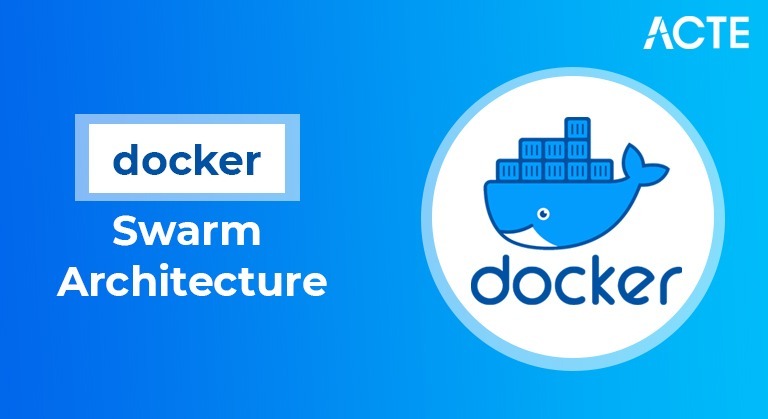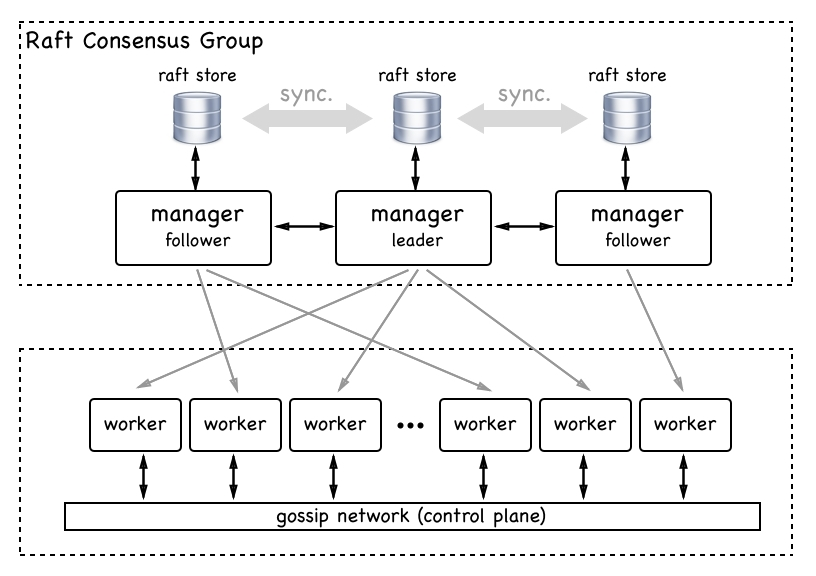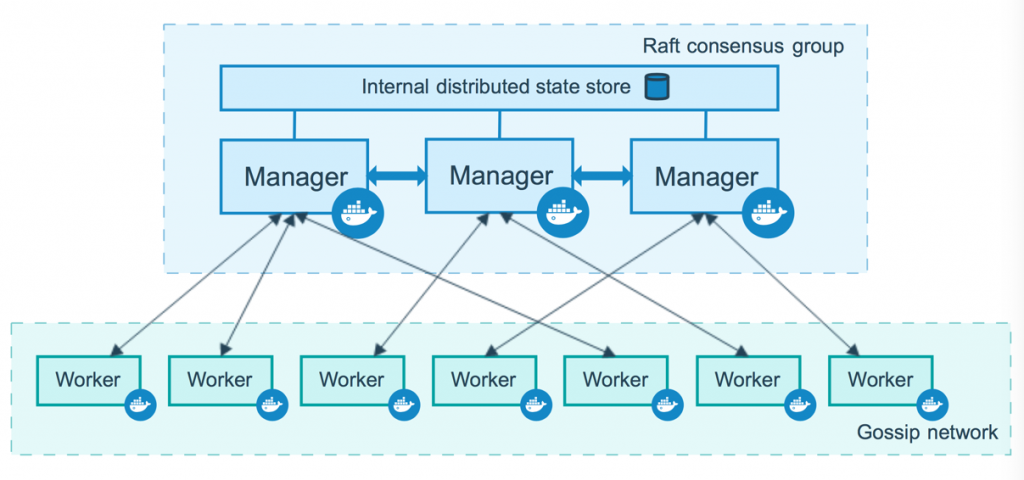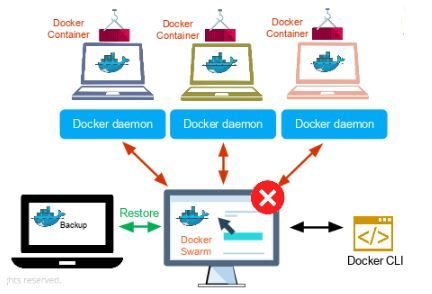
Docker swarm is a container orchestration tool, meaning that it allows the user to manage multiple containers deployed across multiple host machines.
- Introduction to Docker Swarm Architecture
- Typical Docker Swarm Architecture
- Benefits of Docker Swarm Architecture
- What is Docker Swarm?
- Features of Docker Swarm
- Swarm Mode Key Concepts
- How Does Docker Swarm Work?
- Conclusion
- Manager Node: Responsible for all orchestration and field control obligations required to preserve the machine withinside the preferred country including retaining the cluster country, scheduling the offerings and servicing the swarm mode HTTP endpoints.
- Docker Service: It is the venture definition that desires to be executed.
Introduction to Docker Swarm Architecture :-
Docker Swarm is a clustering and Orchestration device for Containers that’s built in in Docker Engine for the allotted machine which entails masses of containers. Docker Node, Docker Services, and Docker obligations are key additives of Docker swarm architecture.Docker Node: It is the Docker Engine example blanketed in Docker swarm, has kinds:-

- Node is the important thing member of docker swarm structure, a swarm structure may have a couple of supervisor nodes lead via way of means of a unmarried supervisor node elected the use of the Raft algorithm, a supervisor node also can paintings as a employee node however may be configured to paintings as supervisor node too.
- Manager nodes use the Raft Consensus Algorithm to internally manipulate the cluster state. This is to make sure that each one supervisor nodes which can be scheduling and controlling responsibilities withinside the cluster maintain/save constant state.
- A swarm is a cluster of Docker Engines or nodes, in which we installation our services. At the early stage, Docker got here up with a cluster control device with a verbal exchange protocol referred to as Beam. Later on, they introduced greater API’s and renamed it to swarm. The first technology swarm is called ‘swarm v1’.
Typical Docker Swarm Architecture :-
Below are the factors for regular docker swarm structure:-
- Decentralized design: we are able to control swarm clusters via swarm command, It offers unmarried p[oint of get entry to to construct complete swarm. It is quite simple in comparison to Kubernetes.
- High Availability: Among the nodes to be had in swarm if grasp fails any other employee node will take upcharge.
- Desired kingdom Reconciliation: The swarm supervisor maintains music of the cluster kingdom in order that the preferred and real kingdom is usually the same. When we specify an over community to connect with your services, the swarm supervisor assigns addresses to the box on overlay community as soon as we create /replace the containers.
- Rolling Updates: Service updates may be executed incrementally swarm supervisor lets in you to specify the put off among each replace with none downtime.
Benefits of Docker Swarm Architecture :-
Below are the factors indicates the blessings of Docker Swarm Architecture:
- Each node of a Docker Swarm is a Docker daemon, and all Docker daemons have interaction the usage of the Docker API. Each field inside the Swarm may be deployed and accessed through nodes of the identical cluster.
- There are 5 vital factors inside a physician surroundings:
- Docker field
- Docker daemon
- Docker images
- Docker client
- Docker registry
- Consider an surroundings having Docker packing containers as shown:
- If one of the packing containers fails, we are able to use the Swarm to accurate that failure.
- Docker Swarm can reschedule packing containers on node failures. Swarm node has a backup folder which we are able to use to repair the facts onto a brand new Swarm.
What is Docker Swarm?
Docker Swarm is an orchestration control device that runs on Docker applications. It allows end-customers in developing and deploying a cluster of Docker nodes:-
- Decentralized get right of entry to: Swarm makes it very smooth for groups to get right of entry to and manipulate the surroundings.
- High security: Any verbal exchange among the supervisor and consumer nodes inside the Swarm is quite secure.
- Autoload balancing: There is autoload balancing inside your surroundings, and you could script that into the way you write out and shape the Swarm surroundings High scalability: Load balancing converts the Swarm surroundings right into a quite scalable infrastructure.
- Roll-lower back a task: Swarm permits you to roll lower back environments to preceding secure environments.
Features of Docker Swarm :-
Some of the maximum important capabilities of Docker Swarm are:-
- Docker packing containers are released the usage of offerings.Services may be deployed in specific ways – worldwide and replicated.
- Global offerings are answerable for tracking packing containers that need to run on a Swarm node. In contrast, replicated offerings specify the wide variety of equal duties that a developer calls for at the host machine.
- Services permit builders to scale their applications.
- Before deploying a provider in Swarm, the developer have to put in force as a minimum a unmarried node.
- Services may be used and accessed with the aid of using any node of the identical cluster.
- A provider is an outline of a assignment, while a assignment plays the work.
- Docker allows a developer in developing offerings, that may begin duties. However, whilst a assignment is assigned to a node, the identical assignment can’t be attributed to any other node.
- A Swarm node is an example of the Docker engine.
- It is viable to run more than one nodes on a unmarried server. But in manufacturing deployments, nodes are disbursed throughout numerous devices.
Swarm Mode Key Concepts :-

Service and Tasks:
Global And Replicated Service:
Node:
- Manager node. Maintains cluster control duties.
- Worker node. Receives and executes duties from the supervisor node.
- Consider a state of affairs in which a supervisor node sends out instructions to unique employee nodes.
- The supervisor node is aware of the reputation of the employee nodes in a cluster, and the employee nodes take delivery of duties despatched from the supervisor node. Every employee node has an agent that reviews at the kingdom of the node’s duties to the supervisor. This way, the supervisor node can keep the favored kingdom of the cluster.
- The employee nodes speak with the supervisor node the use of API over HTTP. In Docker Swarm, offerings may be deployed and accessed with the aid of using any node of the identical cluster. While developing a provider, you may must specify which box photograph you will use. You can installation instructions and offerings to be both worldwide or replicated: a worldwide provider will run on each Swarm node, and on a replicated provider, the supervisor node distributes duties to employee nodes.
- A provider is an outline of a mission or the kingdom, while the real mission is the paintings that desires to be done. Docker allows a person to create offerings which can begin duties. When you assign a mission to a node, it can not be assigned to some other node. It is feasible to have more than one supervisor nodes inside a Docker Swarm surroundings, however there could be simplest one number one supervisor node that receives elected with the aid of using different supervisor nodes.
- Therefore, the running of the Swarm may be summarized as follows:
- A provider is created primarily based totally at the command-line interface. The API that we join in our Swarm surroundings lets in us to do orchestration with the aid of using developing duties for every provider. The mission allocation will permit us to allocate paintings to duties thru their IP address. The dispatcher and scheduler assign and coach employee nodes to run a mission. The Worker node connects to the supervisor node and exams for brand new duties. The very last degree is to execute the duties which have been assigned from the supervisor node to the employee node.
- As we’ve were given a higher knowledge of what’s Docker Swarm, allow us to subsequent check out the variations among Docker swarm and Kubernetes.
How Does Docker Swarm Work?
In Swarm, packing containers are released the use of offerings. A provider is a collection of packing containers of the identical photograph that allows the scaling of applications. Before you could installation a provider in Docker Swarm, you need to have as a minimum one node deployed.There are kinds of nodes in Docker Swarm:-

Conclusion :-
Docker swarm is a easy device in area of large equipment that accomplish the task, Docker with swarm offers orchestration that we need, it’s smooth to installation and ships the local with docker engine which we’re going to set up and use anyway.





